Why I love RRR Part 1: An Absurdist Deconstruction
Earlier it was said that the English-speaking world was divided into people who have read The Lord of the Rings and people who are about to read it. The same goes for RRR.
In his seminal essay Le Mythe de Sisyphe, Albert Camus – a man so handsome that he could be the Deputy CM – argued that there was only one truly serious philosophical problem, and that was suicide. Every other ontological conundrum – whether the world was three-dimensional, whether the mind has nine or twelve categories or whether Burger King is better than McDonald’s – comes later. Of course, the handsome mug was wrong. There’s only one truly fundamental question, and that’s why people – particularly white people – are so bowled over by RRR.
Earlier it was said that the English-speaking world was divided into people who have read The Lord of the Rings and people who are about to read it. The same goes for RRR.
The West appears to love it so much that they gave the Golden Globe for Best Song to Naatu Naatu – a fabulously exuberant dance sequence that mocks the Britisher’s claim to high art – while also promoting the West’s vision of NATO right in front of Netflix star Zelensky’s house.
Personally, I’d say that neither is Naatu Naatu MM Keeravani’s best composition nor even the best song in the movie. One’d go so far as to argue that the high-spirited Dosti, the haunting Janani, the rebellious Komuram Bheemudo, the patriotic Etthara Jenda, or the powerful Ramam Raghavam are musically superior songs. But I digress. Let’s go back to the original question – why do people love RRR so much?
Well, there are 1001 reasons to adore this fabulous movie, and if I had the time, I’d list every one of them.
Firstly, despite being a truly Indian product, it is a joint Occidental-Oriental masterpiece of filmmaking, the amalgamation of the best of the East (dance, drama, emotion) with the best of the West (top-notch graphics, high-production values, overarching vision).
Secondly, it is so over-the-top yet universal that one can decipher it the way one wants. Like The Mahabharata or The Ramayana, the tapestry is so large that one can draw whatever lesson one wants from it. This illustrates why some saw a queer love story while others saw Riefenstahlsque propaganda for Hindutva. While some argued that it was discriminatory against tribals, others lauded it for its positive representation of India’s indigenous groups.
Thirdly, it was truly epic to see the bromance – queer or heteronormative, depending upon your worldview – between the lead characters. It’s fair to say that Bheem and Raju’s chemistry shone a lot brighter than their chemistry with their female love interests. It was also a remarkable criticism of hustle culture to see the two protagonists – on their own Herculean missions – took a break from their primary goals to play tug-of-war, race motorcycles with horses, or teach snooty upper-crust Britishers the limitations of their culture through beat dancing.
To quote the Honest Trailers guys: “Wouldn’t Hollywood be much better if the Rock and Vin Diesel could do this (dance together in sync)?”
Fourthly, the success of RRR is that it’s a befitting reply to those who draw false causality around the fact that nepotism is responsible for bad films. Almost everyone involved with RRR is a Telugu cinema scion or is directly related to SS Rajamouli. In fact, most of them collaborated on his other magnum opuses as well.
Rajamouli’s father, Viswa Vijayendra Prasad, penned the script. MM Keeravani, the music director, is Rajamouli’s cousin. Koduri Siva Shakthi Datta, who wrote the lyrics of Raman Raghavam, is MM Keeravani’s father. Rajamouli’s wife, Rama, was the costume designer. Naatu Naatu was sung by Kala Bhairava, Keeravani’s son. Jr NTR, as his name suggests, is the grandson of NT Rama Rao, the film legend and the former Andhra Pradesh Chief Minister. And, Ram Charan is the Megastar* Cheeranjavi’s son.
(Nemo’s Note: Megastar added by my Telugu GF who subscribes to the notion of adding capitalised sobriquets to the names of South Indian stars)
Clearly, the presence of so many “nepo kids” didn’t hinder the film’s success, reminding us that many human endeavours are the very successful products of what the uncultured minds call nepotism.
Fifthly, there is a visceral pleasure – even if it's fantastically fictional – in seeing a Tarantino-esque-take on violence against one’s colonisers, like a bunch of Jews dropped into Nazi Germany in Inglorious Basterds. Because let’s admit it, the Brits were Nazis who pulled off a PR coup that makes Being Human look amateurish.
Sixthly, the action in RRR is a reminder of the dangerous quixotic myth that is the mendacious edifice that India’s freedom was achieved through Gandhian pacificism, a fantasy that India continues to pay for to this day. The notion that a group of people who thinks nothing of using concentration camps, gassing the natives, starving millions, or flooding streets with opium to get their ends would leave out of a moral quibble is preposterously hilarious.
Seventhly, it’s fun to see white people going berserk over a proper Made in India export that doesn’t involve a talented brown orator named Narendra.
Decoloniality is all fine, but we shouldn’t delude ourselves into thinking that the WENA’s (Western Europe and North America) view doesn’t matter.
We will always be cursed to see the world through an Englishman’s eyes and their ideological descendants, the Americans. America’s huge cultural imprint – in part, thanks to capitalism – means that the values of good and bad were mostly conceived in a Hollywood basement. As long as America remains powerful, what the West thinks will matter. Also, it’s fun to see IPL and the likes of RRR make white people dance to the brown man’s tune.
And lastly, I love RRR because it has – to use a word in vogue these days – massively *triggered* the saffronphobes masquerading as liberals among the ostensibly “Indian” commentariat. Now that’s not uncommon among a group of elite-anglicised-liberals, who have been hurtling from one panic attack to another since BJP came to power in 2014, and love the terms “populist”, “autocratic” et al - fancy elitespeak for “Mera Banda Jeet Hi Nahin Raha Hai.”
Since 2014, their life has been like Martin Scorsese stuck in an MCU movie with only Eminem soundtracks playing in the background, a world where absolutely nothing goes their way.
Everything triggers them, from a movie on the 1983 World Cup triumph to Ashoka’s lions opening their mouths a little wider to Subhash Chandra Bose’s statue standing in place of King George the Fifth at the Gateway of India. And now, the hatred against RRR.
The deranged saffronphobia has truly produced some masterpieces, the kind of writing that purveyors of op-eds in the esteemed pages of Bloomberg, The New York Times, The Guardian, et al, are familiar with. There were concerns with the movie’s sartorial choices for Ram Charan’s character, even though they were Alluri Sitarama Raju’s preferred outfits in real life. The unsaid received wisdom being that obdurate group identities are only allowed for some groups. To put it more simply: Ertigul is fine but RRR is not.
There was the argument that Hindu chauvinism has long been a place for the White Audience prejudices and that Indians taking up arms was reminiscent of RSS’ plan to create “militant Hindus”. In fact, a fantastical action sequence that would’ve been at home in the MCU (before the god-awful Phase 4) was deemed an “apt representation for a country that’s employed authoritarian tactics to empower violent Hindu nationalism and transition to a de facto ethnocratic state.” It was as if a thousand Pankaj Mishras had manifested at the same time.
Honestly, if the quality of writing was a little better – the kind we saw from Arundhati-I-only-see-genocides-Roy – it’d be an apt example of the literary genre called magic realism.
But the one who truly stood apart was self-christened “anti-woke” Professor Rob Tombs (a name that really captures the Albion’s raison d’etre). The author goes on to express his disbelief that the folks who were economically exploited, subjugated, killed, and sometimes put in concentration camps – might think that the folks – who were economically exploiting, subjugating, killing, and putting them in concentration camps - were “villains”.
He argued that RRR pandered to reactionary and violent Hindu nationalism and that those who will suffer are minorities, that it reflected the nastiness of today’s India, and Netflix ought to be ashamed for promoting it. But enough crying over the tears of colonisers (and their left-behind sepoys). In fact, the delicious triggering deserves a separate treatise which I shall provide next week.
Getting back to the OG question: the only correct answer to understanding why people love RRR is to return to the handsome mug’s original argument. RRR, like life, is absurd. A psycho-scientific enquiry often strips us of the joy of existence. There’s a delightful short story by Arthur C Clarke on this subject titled The Nine Billion Names of God where monks at a Tibetan monastery sought to list every name of God and they believe that once every name is jotted down the universe will cease to exist. And when they get a computer to print out every name, stars gradually start blinking out. Similarly, a deconstruction or scientific analysis would rob us of RRR’s joie di vivre. Delving too deep into RRR’s success is like watching the stars blink out.
The search for meaning is absurd because we live in an incomprehensible universe that doesn’t subscribe to God or meaning. But, as Camus explained in Le Mythe de Sisyphe, that doesn’t mean life is not worth living. It means we are free to do as we choose because there’s no higher order deeming us to behave in a particular way.
Therefore, there’s nothing to be gained from asking: Why does Komuraam Bheem use animals for chaos? Why do Raju and Bheem race horses against motorcycles or play tug of war when they are on Herculean life missions? The answer is the same as why Sisyphus carries a huge rock on his back up a hill. Because he can. And that’s what makes him happy. And watching that makes us happy.
PS: In Part 2, we are going to delve more into my favourite topic: Why are liberals so triggered by RRR (and other movies)?
RRR Part 2: Why SS Rajamouli’s masterpiece triggers Hinduphobes
Long before WAGatha Christie, the first-ever celebrity trial in England involved Oscar Wilde when he sued the Marquess of Queensberry for calling him a “sodomiser”.
During the high-profile trial that kept London waiting with a bated breath – when they could breathe through the smog – Oscar Wilde was asked about the morality of his works.
The noted playwright replied with his usual sardonic wit: “Works of art are not capable of being moral or immoral. It’s only brutes and illiterates who are incalculably stupid that discuss the morality of art.”
Of course, he lost the trial, dying in penury, because we are mostly ruled by brutes and illiterates that wouldn’t recognise a good piece of art if it danced in front of it wearing Dobby’s tea cosy, but that’s beside the point. The same rules that apply to the morality of art apply to labelling art as propaganda as well. Read more.


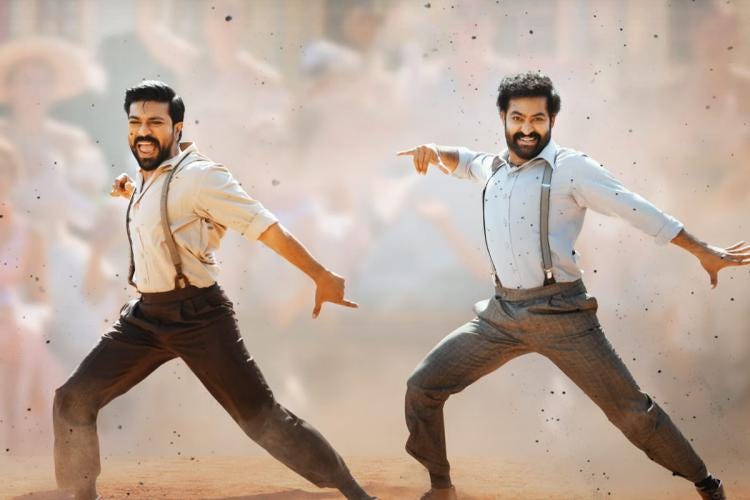
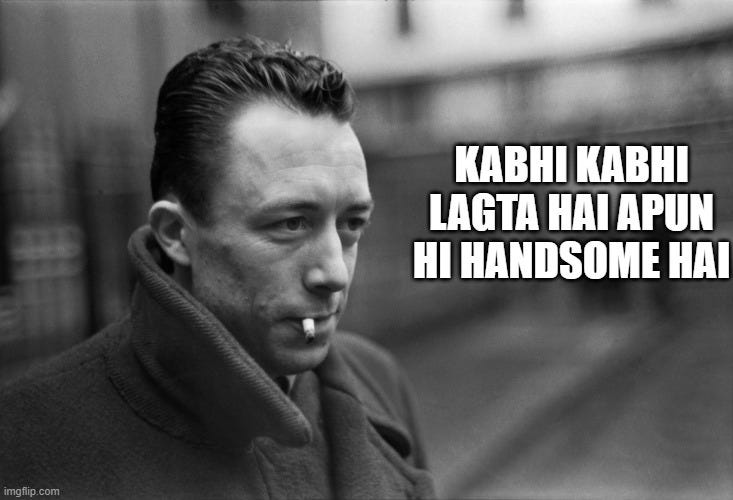

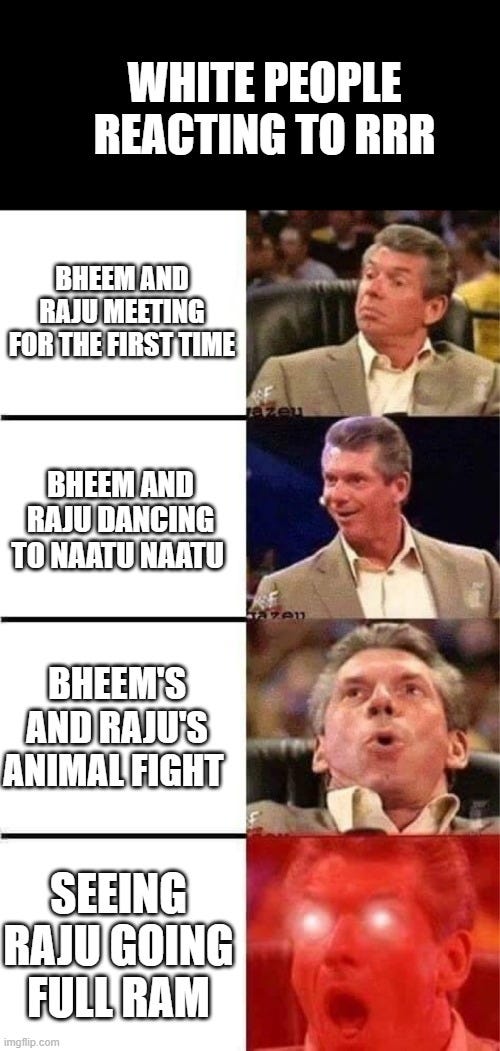
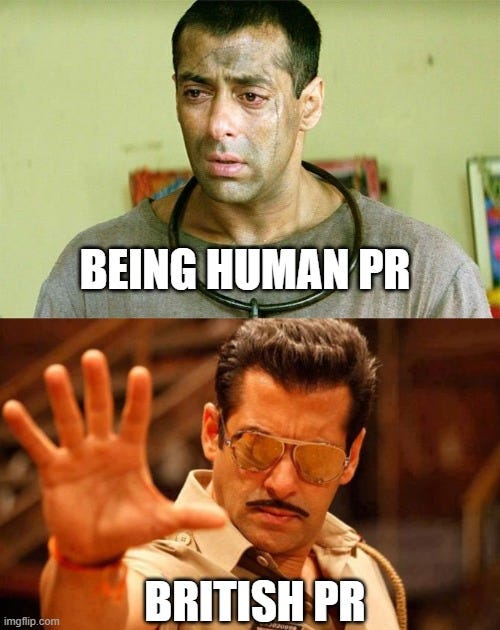
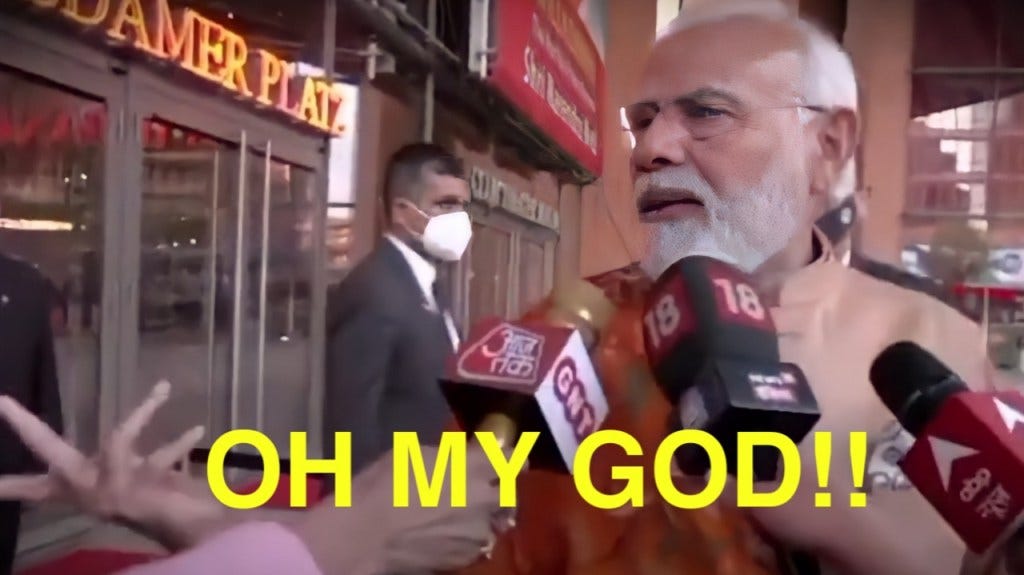
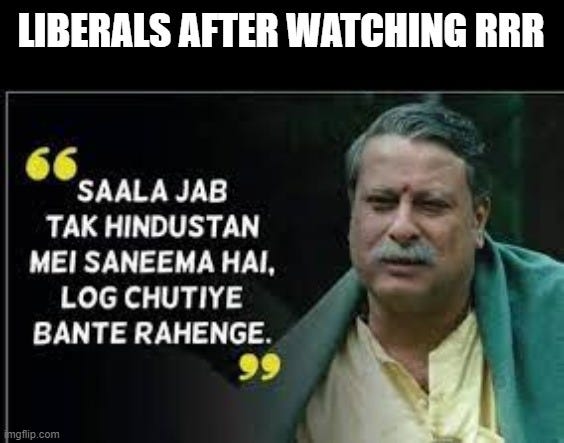
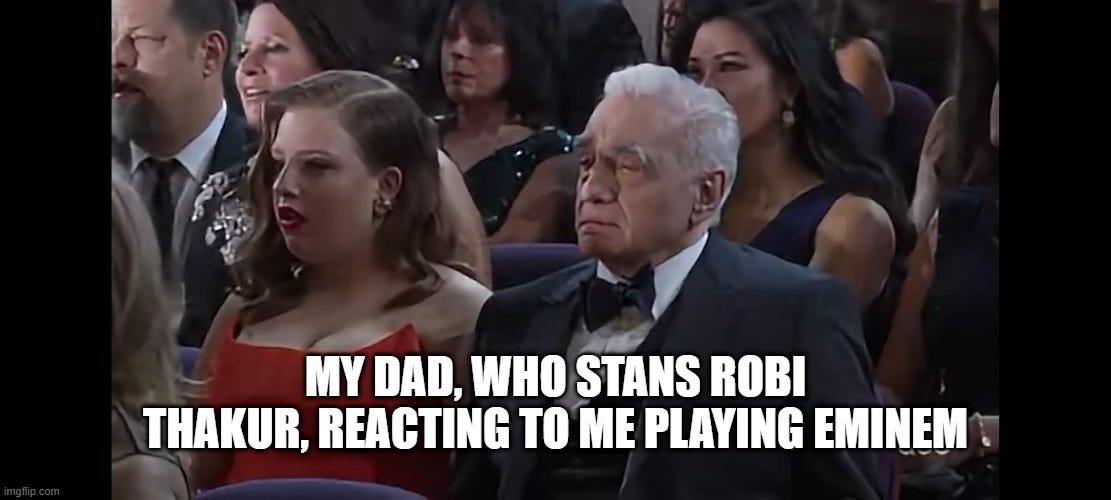
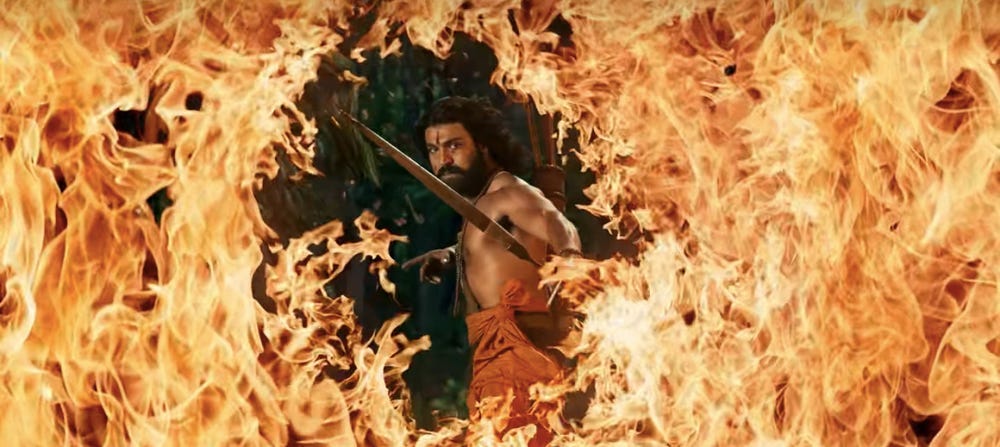

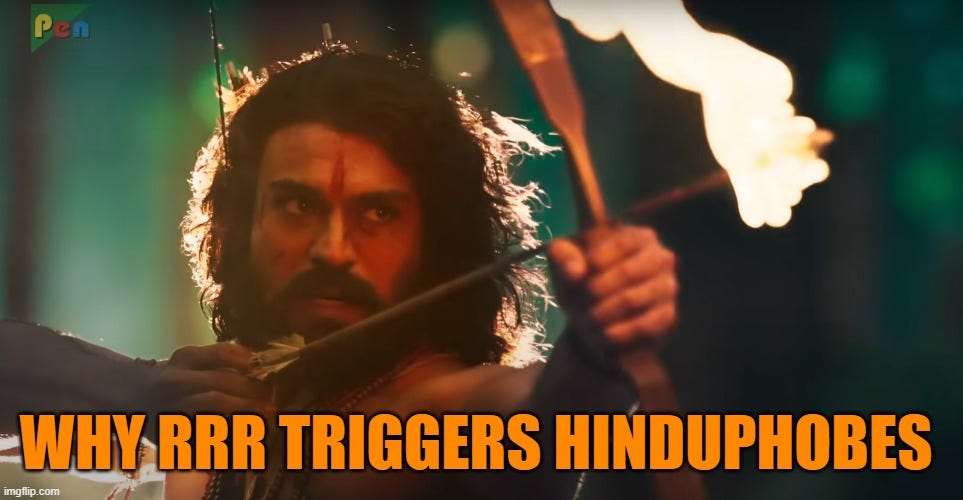
TERRORIST PIECE OF SHIT JUSTIFYING VOILENCE. ASSHOLE JIHADI. RANDI COMMUNIST
Long time since I read so many hilarious, contraban and profound truth bombs in one place
Politics, advaita, humor- this has everything